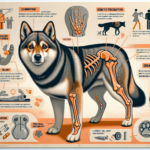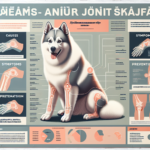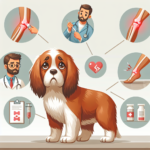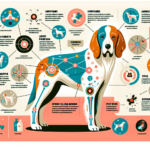Swedish Vallhund Joint Pain: Causes, Symptoms, Prevention, and Treatment

Introduction
The Swedish Vallhund, also known as the “Viking Dog,” is a small, robust herding breed with a rich history dating back over a thousand years. Originating in Sweden, this breed is known for its agility, intelligence, and versatility. Swedish Vallhunds are characterized by their wolf-like appearance, with a sturdy build, erect ears, and a distinctive tail that can be either long or naturally bobbed. They are highly energetic and excel in various dog sports and activities, making them a favorite among active dog owners.
While Swedish Vallhunds are generally healthy, they are not immune to certain health issues. Common concerns include eye problems, dental issues, and joint-related conditions. Joint pain, in particular, can significantly impact the quality of life for these active dogs, making it a crucial area of focus for owners and veterinarians alike.
Maintaining joint health is especially important for Swedish Vallhunds due to their high activity levels and the physical demands of their traditional herding roles. Ensuring that their joints remain healthy can help prevent pain and mobility issues, allowing them to lead active, fulfilling lives.
Breed-Specific Joint Pain Risks
Genetic Predisposition
Swedish Vallhunds, like many other breeds, can be genetically predisposed to joint-related issues. Hip dysplasia, a condition where the hip joint does not fit properly into the hip socket, is one of the most common genetic concerns. This can lead to arthritis and significant pain over time. Elbow dysplasia, another hereditary condition, affects the elbow joint and can also result in chronic pain and lameness.
Age-Related Risks
As Swedish Vallhunds age, the risk of developing joint pain increases. Arthritis, a degenerative joint disease, is particularly common in older dogs. Owners should be vigilant as their Vallhunds approach middle age, typically around 6-8 years, and monitor for any signs of joint discomfort. Early detection and intervention can help manage symptoms and improve the dog’s quality of life.
Activity Level and Joint Stress
Swedish Vallhunds are known for their high energy levels and love for physical activities such as herding, agility, and obedience training. While regular exercise is essential for their overall health, excessive or inappropriate activities can put undue stress on their joints. Owners should balance their Vallhund’s exercise routine to ensure it is both stimulating and safe for their joints.
Common Symptoms of Joint Pain in Swedish Vallhunds
General Symptoms
- Limping: One of the most noticeable signs of joint pain is limping or favoring one leg over another.
- Stiffness: Dogs with joint pain may exhibit stiffness, especially after resting or during cold weather.
- Reluctance to Move: A dog in pain may be hesitant to engage in activities they once enjoyed, such as running or jumping.
- Swelling: Visible swelling around the joints can indicate inflammation and discomfort.
- Behavioral Changes: Irritability, lethargy, or changes in appetite can also be signs of joint pain.
Breed-Specific Symptoms
In Swedish Vallhunds, joint pain may manifest in specific ways due to their unique build and activity levels. Owners might notice a decrease in their dog’s agility performance or reluctance to participate in herding activities. Additionally, Vallhunds may show discomfort when climbing stairs or jumping onto furniture, activities they typically enjoy.
When to Consult a Vet
If you observe any of the above symptoms in your Swedish Vallhund, it is essential to consult a veterinarian promptly. Early diagnosis and treatment can prevent further deterioration and improve your dog’s quality of life. Regular veterinary check-ups are also crucial for monitoring joint health and catching any issues early.
Preventive Measures for Joint Health
Exercise Recommendations
Regular, moderate exercise is vital for maintaining joint health in Swedish Vallhunds. Activities such as walking, swimming, and controlled play can help keep their joints flexible and muscles strong. Avoid high-impact exercises like excessive jumping or running on hard surfaces, as these can exacerbate joint stress. Incorporating low-impact activities like swimming can be particularly beneficial, as it provides a full-body workout without putting pressure on the joints.
Dietary Suggestions
A balanced diet rich in essential nutrients can support joint health. Look for dog foods that contain glucosamine and chondroitin, which help maintain cartilage health. Omega-3 fatty acids, found in fish oil supplements, can reduce inflammation and support overall joint function. Always consult your veterinarian before adding supplements to your dog’s diet to ensure they are appropriate and safe.
Weight Management
Maintaining a healthy weight is crucial for reducing joint stress in Swedish Vallhunds. Excess weight can exacerbate joint pain and lead to other health issues. Monitor your dog’s weight regularly and adjust their diet and exercise routine as needed. Your veterinarian can provide specific guidelines for maintaining an ideal weight based on your dog’s age, size, and activity level.
Early Screening and Monitoring
Regular veterinary check-ups and early screening for joint issues can help catch problems before they become severe. For Swedish Vallhunds, consider screening for hip and elbow dysplasia, especially if you plan to breed your dog. Early detection allows for timely intervention and can significantly improve your dog’s quality of life.
Treatment Options for Joint Pain
Non-Surgical Treatments
Non-surgical treatments are often the first line of defense against joint pain. These may include:
- Medications: Nonsteroidal anti-inflammatory drugs (NSAIDs) can help reduce pain and inflammation. Your veterinarian may also prescribe pain relievers or joint supplements.
- Physical Therapy: Therapeutic exercises and stretches can improve joint mobility and strengthen supporting muscles. Hydrotherapy, or water-based exercises, can be particularly effective.
- Lifestyle Adjustments: Modifying your dog’s activity level and providing a comfortable living environment can help manage pain. Soft bedding, ramps, and avoiding slippery surfaces can make a significant difference.
Surgical Options
If non-surgical treatments are not effective, surgical intervention may be necessary. Common surgical options for joint pain include:
- Hip Replacement: In severe cases of hip dysplasia, a total hip replacement can provide significant pain relief and improved mobility.
- Arthroscopy: This minimally invasive procedure can be used to diagnose and treat joint issues, such as removing loose cartilage or repairing ligaments.
- Joint Fusion: In cases of severe arthritis, fusing the joint can stabilize it and reduce pain.
Alternative Therapies
Alternative therapies can complement traditional treatments and provide additional relief. These may include:
- Acupuncture: This ancient practice involves inserting thin needles into specific points on the body to relieve pain and promote healing.
- Hydrotherapy: Water-based exercises can improve joint mobility and reduce pain without putting stress on the joints.
- Massage: Regular massage can help relax muscles, improve circulation, and reduce pain.
Lifestyle and Management Tips
Daily Care Routine
A consistent daily care routine can help manage joint pain in Swedish Vallhunds. This might include:
- Providing regular, moderate exercise tailored to your dog’s needs.
- Feeding a balanced diet with joint-supporting nutrients.
- Administering any prescribed medications or supplements.
- Incorporating physical therapy exercises into your dog’s routine.
Modifying the Home Environment
Making your home more comfortable for a dog with joint pain can significantly improve their quality of life. Consider the following modifications:
- Using ramps or stairs to help your dog access furniture or vehicles.
- Providing orthopedic beds that offer better support for their joints.
- Ensuring that your home has non-slip surfaces to prevent falls.
Long-Term Management
Long-term management of joint pain involves ongoing care and monitoring. Regular veterinary check-ups, maintaining a healthy weight, and adjusting your dog’s exercise routine as needed are all essential components. Staying informed about new treatments and therapies can also help you provide the best care for your Swedish Vallhund.
FAQs About Swedish Vallhunds and Joint Pain
What are the early signs of joint pain in Swedish Vallhunds?
Early signs of joint pain include limping, stiffness, reluctance to move, and behavioral changes such as irritability or lethargy. If you notice any of these symptoms, consult your veterinarian promptly.
Can joint pain in Swedish Vallhunds be prevented?
While genetic predispositions cannot be entirely prevented, maintaining a healthy weight, providing regular exercise, and feeding a balanced diet with joint-supporting nutrients can help reduce the risk of joint pain.
Are there specific exercises that are better for Swedish Vallhunds with joint pain?
Low-impact exercises such as walking, swimming, and controlled play are ideal for Swedish Vallhunds with joint pain. Avoid high-impact activities that can exacerbate joint stress.
What dietary supplements can help with joint health in Swedish Vallhunds?
Supplements containing glucosamine, chondroitin, and omega-3 fatty acids can support joint health. Always consult your veterinarian before adding supplements to your dog’s diet.
When should I consider surgery for my Swedish Vallhund’s joint pain?
Surgery should be considered if non-surgical treatments are not effective and your dog is experiencing significant pain or mobility issues. Consult your veterinarian to discuss the best surgical options for your dog’s specific condition.
Conclusion
Joint pain is a common concern for Swedish Vallhunds, but with proper care and attention, it can be managed effectively. By understanding the breed-specific risks, recognizing early symptoms, and implementing preventive measures, owners can help their Vallhunds maintain healthy joints and lead active, fulfilling lives. Regular veterinary check-ups and staying informed about new treatments are essential for ensuring your dog’s joint health. Remember, early intervention and consistent care are key to keeping your Swedish Vallhund happy and pain-free.




